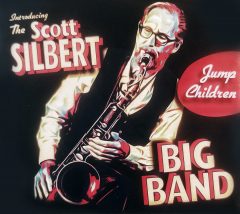

Little else gets the blood pumping than the pulverizing rhythm of big band swing. Arms twitch, hands beat a tempo on tabletops, feet tap then turn and twist in acrobatic dervishing as the ballroom floor fills with the righteous joy of dancers moving to the galvanizing pace of trombones, trumpets, and saxophones galore joined in a righteous 4/4 stride. In its prime, in the ’30s, ’40s and up to the ’50s, it was the music supreme. Ellington, Basie, Goodman, Harry James, the Dorsey brothers, and many others filled ballrooms, concert halls, and radio airwaves coast to coast.
It was rebellion, rhythm, pot, secret hooch in pocket flasks, riffs, romance, the music of a nation on the go—on the dance floors, in the factories, on the march in the War to End all Wars as America seduced the world with the sweetest sounds this side of heaven. I’m nearly 70, born too early to remember what a monumental big deal big bands were, but decades of speaking to elders kind enough to share their memories and record collections with me, I think it would be safe to assume that collectively those telling me tales of big bands, tour buses, and bandstands thought that this was a glorious thing that would never end. But it did.
The eventual ascendancy of Elvis, Chuck Berry, and rock ‘n’ roll in general in the ’50s, to make a complicated tale too brief in the telling, was a principal reason that big bands were pushed from the center spotlight. Though never completely out of the public mind, jazz in general and big band jazz in particular became marginalized. Efforts over the years to restart interest in the Swing Era brand of brassy sass have had mixed results over the years. In a general way and in the interest of keeping this review concise, suffice it to say that college big bands, various sorts of revivalist ensembles and especially that faddish “Swing Revival” of the late eighties-early ’90s struck me as academic recreations at best, gimmicky opportunism at worst. You couldn’t help but wonder if anyone would happen along, unexpected, with a blazing take on this grand tradition, but not as an ancient thing that needed to be refurbished or rehabilitated instead as a life force that can make the nervous system jump again in an age where modern music seems determined to deaden our wits.
Jump Children by the Jeff Silbert Big Band is a choice step in that direction, a session of hard-rocking swing music, fueled by propulsive drums; two-fisted piano chords; and sharp, superbly textured, rapidly applied horn and reed arrangements. Silbert, a jaunty and fluid tenor saxophonist and arranger as well as a member of the Smithsonian Jazz Masterworks Orchestra, proceeds here as though big bands never went out of style. He’s assembled a formidable 14-member band, players who lock together in common cause to move the listener through deep, brash colors and intricate time signatures. There’s abundance of ensemble electricity here. Or more like an embarrassment of ridiculously hot jazz.
A bold statement, but the music’s galloping swagger is evidence that enthralls and rattle the senses. The album opener and title track “Jump Children,” a tune recorded in 1945 by the International Sweethearts of Rhythm (an all-women unit that found a measure of international acclaim) is given a blasting, endearingly fidgety treatment here, with fine solos from trumpeter Josh Kauffman on trumpet and Grant Langford on tenor sax, swiftly and lightly darting over and around the cut time horn arrangements, all of which boosts Gretchen Midgely’s already animated vocals to heights of finger-snapping jive. This collective of virtuosos through a rich swath of known and less known tunes from the period, performed with a superb rhythm section that makes the music move with a youthful flair you might not have expected. There is nothing dated here. There are many sweet spots, but I would point out two especially catchy numbers, the first being an intrepid iteration of 1939’s “In a Persian Market” by Larry Clinton, which indulges in magnificent stop-time fun after the main theme is played.
Second, the Silbert Big Band’s treatment of Mercer Ellington’s “Jumpin’ Punkin” from 1941 is an elegant jaunt, a spare set of horn charts laced together with sublime statements from multi-reedist on clarinet and Leigh Pilzer on baritone sax. The album concludes on a stratospheric note, the warhorse tune “Stompin at the Savoy” (composed by Chick Webb and Edgar Samson), the trademarked horn charts soaring over a brutally effective swing section while a round house of soaring and succinct solos from Kauffman (trumpet), Jen Krupa (trombone), Silbert (tenor sax) and Ken Kimrey switch off with the unison horn lines in a melee of musical chatter. What’s wonderful through out this rousing exhibition of rhythm is Silberg’s refusal to let this great music waste away in textbooks, scratchy records stacked in the attic, or in the collective memory. The Scott Silberg Big Band keeps it relevant by keeping the music snappy, happy, and full of vim and vigor.